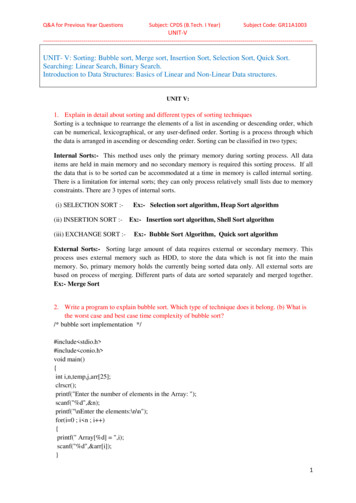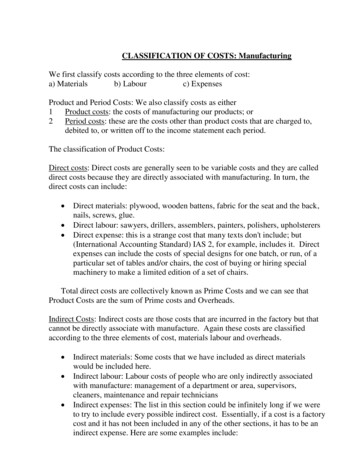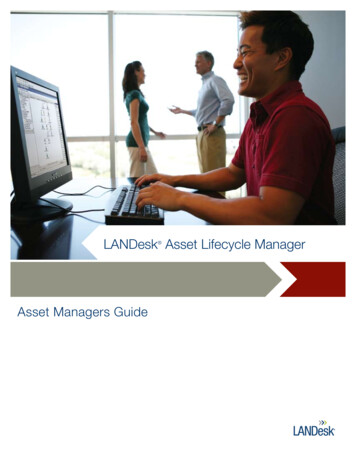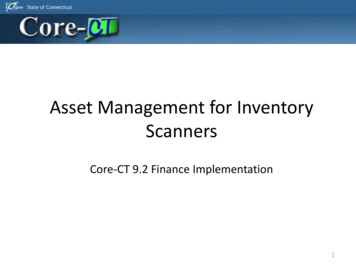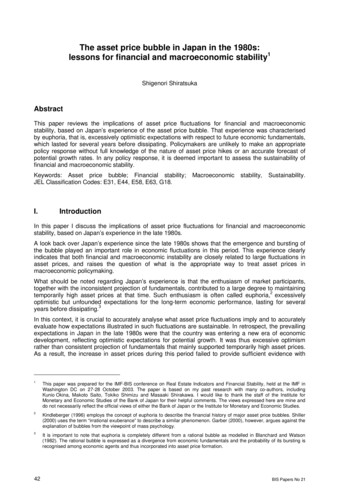
Transcription
The asset price bubble in Japan in the 1980s:lessons for financial and macroeconomic stability1Shigenori ShiratsukaAbstractThis paper reviews the implications of asset price fluctuations for financial and macroeconomicstability, based on Japan’s experience of the asset price bubble. That experience was characterisedby euphoria, that is, excessively optimistic expectations with respect to future economic fundamentals,which lasted for several years before dissipating. Policymakers are unlikely to make an appropriatepolicy response without full knowledge of the nature of asset price hikes or an accurate forecast ofpotential growth rates. In any policy response, it is deemed important to assess the sustainability offinancial and macroeconomic stability.Keywords: Asset price bubble; Financial stability;JEL Classification Codes: E31, E44, E58, E63, uctionIn this paper I discuss the implications of asset price fluctuations for financial and macroeconomicstability, based on Japan’s experience in the late 1980s.A look back over Japan’s experience since the late 1980s shows that the emergence and bursting ofthe bubble played an important role in economic fluctuations in this period. This experience clearlyindicates that both financial and macroeconomic instability are closely related to large fluctuations inasset prices, and raises the question of what is the appropriate way to treat asset prices inmacroeconomic policymaking.What should be noted regarding Japan’s experience is that the enthusiasm of market participants,together with the inconsistent projection of fundamentals, contributed to a large degree to maintainingtemporarily high asset prices at that time. Such enthusiasm is often called euphoria,2 excessivelyoptimistic but unfounded expectations for the long-term economic performance, lasting for severalyears before dissipating.3In this context, it is crucial to accurately analyse what asset price fluctuations imply and to accuratelyevaluate how expectations illustrated in such fluctuations are sustainable. In retrospect, the prevailingexpectations in Japan in the late 1980s were that the country was entering a new era of economicdevelopment, reflecting optimistic expectations for potential growth. It was thus excessive optimismrather than consistent projection of fundamentals that mainly supported temporarily high asset prices.As a result, the increase in asset prices during this period failed to provide sufficient evidence with1This paper was prepared for the IMF-BIS conference on Real Estate Indicators and Financial Stability, held at the IMF inWashington DC on 27-28 October 2003. The paper is based on my past research with many co-authors, includingKunio Okina, Makoto Saito, Tokiko Shimizu and Masaaki Shirakawa. I would like to thank the staff of the Institute forMonetary and Economic Studies of the Bank of Japan for their helpful comments. The views expressed here are mine anddo not necessarily reflect the official views of either the Bank of Japan or the Institute for Monetary and Economic Studies.2Kindleberger (1996) employs the concept of euphoria to describe the financial history of major asset price bubbles. Shiller(2000) uses the term “irrational exuberance” to describe a similar phenomenon. Garber (2000), however, argues against theexplanation of bubbles from the viewpoint of mass psychology.3It is important to note that euphoria is completely different from a rational bubble as modelled in Blanchard and Watson(1982). The rational bubble is expressed as a divergence from economic fundamentals and the probability of its bursting isrecognised among economic agents and thus incorporated into asset price formation.42BIS Papers No 21
which to assess whether this rise was the consequence of the advent of a new economy or justeuphoria.This paper is organised as follows. Section II summarises the characteristics of the asset price bubblein the late 1980s by reviewing Japan’s experience of asset price booms in the postwar period.Section III verifies the lessons of asset price bubbles regarding financial and macroeconomic stability.Section IV discusses policy implications regarding how to deal with major fluctuations in asset prices inmacroeconomic policymaking. Section V examines policy implications in a more practical manner byconducting a case study exercise based on Japan’s macroeconomic conditions in the late 1980s.Section VI concludes.II.Japan’s asset price bubble in the late 1980sIn this section I summarise the characteristics of the asset price bubble in the late 1980s, based onJapan’s historical experience of asset price inflation in the postwar period.A.Japan’s asset price fluctuations in the post-WW II periodFigure 1 plots major financial and economic indicators, including asset prices such as stock and landprices in the postwar period. The figure plots stock prices and land prices as indicators for asset prices(first panel), the consumer price index, the domestic wholesale price index, and the GDP deflator asindicators of the general price level (second panel), the growth rate of real GDP, and theunemployment rate as indicators for demand-supply conditions (third panel), and M2 CDs andnominal GDP (last panel).The figure shows Japan experienced three major boom-bust cycles in asset prices in the postwarperiod: (1) the Iwato boom in the second half of the 1950s; (2) the boom of Prime Minister Tanaka’s“remodelling the Japanese archipelago” project; and (3) the Heisei boom in the late 1980s to early1990s.First, at the time of the Iwato boom, when Japan’s economy entered the so-called “high economicgrowth period”, asset prices increased rapidly, reflecting an improvement in fundamentals due totechnological innovations. The real economic growth rate exceeded 10% per annum, driven mainly byinvestment demand due to technological innovations that replaced the post World War IIreconstruction demand. On the price front, consumer prices rose while wholesale prices remainedgenerally stable, thus leading to the so-called “productivity difference inflation”.Second, during the period from the “remodelling the Japanese archipelago”4 boom to the first oil crisis,asset prices increased and then the general price level sharply rose due to the excessively highgrowth of the money stock and oil price hikes stemming from the first oil crisis. In the meantime, realeconomic growth rapidly declined, marking an end to the high economic growth period.Third, in the Heisei boom, asset prices increased dramatically under long-lasting economic growth andstable inflation. Okina et al (2001) define the “bubble period” as the period from 1987 to 1990, from theviewpoint of the coexistence of three factors indicative of a bubble economy, that is, a markedincrease in asset prices, an expansion in monetary aggregates and credit, and an overheatingeconomy. The phenomena particular to this period were stable CPI inflation in parallel with theexpansion of asset prices and a long adjustment period after the peaking of asset prices.The decline in asset prices was initially regarded as the bursting of the asset price bubble, and anamplifying factor of the business cycle. Although the importance of cyclical aspects cannot be denied,4Kakuei Tanaka, who became Prime Minister in 1972, effected extremely aggressive public investment based on his belief(remodelling the Japanese archipelago) that it was necessary to resolve overpopulation and depopulation problems byconstructing a nationwide shinkansen railway network, which led to an overheated economy.BIS Papers No 2143
further declines in asset prices after the mid-1990s seem to reflect the downward shift in the trendgrowth rate beyond the boom-bust cycle of the asset price bubble (Figure 2).5B.Mechanism behind the emergence and expansion of the bubbleFocusing on the third episode above, the bubble was generated by the complex interaction of variousfactors as a process of “intensified bullish expectations” (Figure 3).The intensified bullish expectations are clearly observed in the increased equity yield spread duringthe period from the late 1980s to the early 1990s (Figure 4). As reported by Okina et al (2001), theexpected growth rate of nominal GDP computed from the equity yield spread in 1990 is as high as 8%with the standard assumption based on the discount factor. However, in view of the low inflation at thetime, it was unlikely that the potential growth rate of nominal GDP was close to 8%. Hence, it would bemore natural to infer that the high level of the yield spread in 1990 reflected the intensification ofbullish expectations, which were not sustainable in the long run.The intensified bullish expectations were certainly grounded in several interconnected factors. Thefactors below are often pointed out as being behind the emergence and expansion of the bubble: aggressive behaviour of financial institutions progress of financial deregulation inadequate risk management on the part of financial institutions introduction of the Capital Accord protracted monetary easing taxation and regulations biased towards accelerating the rise in land prices overconfidence and euphoria overconcentration of economic functions in Tokyo, and Tokyo becoming an internationalfinancial centreFocusing on monetary factors, it is important to note the widespread market expectations that the thenlow interest rates would continue for an extended period, in spite of clear signs of economicexpansion. The movement of implied forward rates from 1987 to 1989 (Figure 5) shows that the yieldcurve flattened while the official discount rate was maintained at a low level.6III.Adverse effects on financial and macroeconomic stabilityIn this section, I selectively examine the lessons of Japan’s asset price bubble in terms of financial andmonetary stability. I take up three points below: (i) the build-up of risks during the period of bubbleexpansion; (ii) the vulnerability of the bank-based financial system; and (iii) the weakened effects ofmonetary easing.5The bursting of the asset price bubble not only triggered the materialisation of adverse effects but also amplified them astime passed, thereby making structural adjustment more difficult. This incomplete economic adjustment to major changes ina relative price system resulted in the downward shift in growth trend in the 1990s, thereby amplifying the asset pricedecline beyond the boom-bust cycle.6The implied forward rate is the future interest rate estimated from market rates with a different time to maturity. For example,the implied forward rate for three years ahead gradually increased from June 1987. As the BOJ conducted a slightly tightermonetary operation from September 1987, it rose to a level over 6% in the autumn. However, expectations of higher interestrates receded after the worldwide plunge of stock prices in October of the same year, and the implied forward ratedecreased to around 5%. After the spring of 1988, the stock market gradually recovered and the economy once againshowed clear signs of expansion. Nevertheless, the rate basically remained flat at around 5% towards the spring of 1989.44BIS Papers No 21
A.Build-up of risks during the period of bubble expansionThe first lesson is that risks of financial and macroeconomic instability build up during asset pricebooms and materialise as an aftermath of asset price declines and recessions.7 In the light of Japan’sexperience, it seems to be a characteristic that the effects of a bubble are asymmetrically larger in thebursting period than in the expansion period.A rise and fall in asset prices, which contain an element of a bubble, influence real economic activitymainly through two routes: (i) consumption through the wealth effect, and (ii) investment through achange in the external finance premium due to changes in collateral and net asset values.8 As long asasset prices are rising, they influence the economy in a favourable way and the adverse effects arenot thoroughly recognised.However, once the economy enters a downturn, the above favourable cycle reverses, thereby leadingto a severe reaction. The harmful effects of a bubble will emerge, exerting stress on the real side ofthe economy and the financial system due to an unexpected correction of asset prices. If intensifiedbullish expectations which previously supported the bubble are left unchecked, the expansion andsubsequent bursting of the bubble will become more intense, affecting the real economy directly or, bydamaging the financial system, indirectly.Looking at the land price problem from the viewpoint of the stability of the financial system, it was therisk brought about by the sharp rise in land prices and the concentration of credit in the real estate andrelated industries that were insufficiently perceived. During the bubble period, real estate wasgenerally accepted as collateral. However, if the profitability of businesses financed by secured loansis closely related to collateral value, such loans become practically unsecured since profits andcollateral value move in the same direction.In fact, Shimizu and Shiratsuka (2000) show a simple numerical exercise, which is based on ananalytical framework of value-at-risk (VaR) and enables us to sufficiently predict the magnitude ofnon-performing loans held by Japanese banks in the 1990s (“stress testing”). The exercise estimatesthe aggregate credit risk inherent in the loan portfolio of Japanese banks during the bubble period byassuming sufficiently prudent scenarios for the probability of bankruptcy, the concentration of creditand the future fluctuation of collateral prices (see Figure 6 for the scenario for land price fluctuation,and Table 1 for the estimation results).9It should be noted, in this context, that the interaction of risks takes various forms, and such aggregaterisks are not merely the simple sum of risks recognised by individual economic agents. It might well bethe case that insufficient recognition of the interaction of various risks in the economy leads to anexcessive concentration of risk. It is thus deemed important to recognise the risk profile of theeconomy as a whole, which might adversely affect sound financial and economic conditions from themedium- to long-term viewpoint.Moreover, the effect of asset price fluctuations is asymmetric, with a stronger effect in the case of anasset price decline, because the collapse in asset prices has adverse effects on the stability of thefinancial system. Changes in cash flow and asset prices arising from cyclical movements in firms’ networth tend to affect agency costs and credit conditions, thereby influencing firms’ investmentbehaviour. It is important to note that the capital base functions as a buffer against future risks andlosses. Although this function is not clearly recognised as long as the economy is expanding smoothly,the adverse effects of having an insufficient capital base will materialise once the outlook for economicexpansion changes.7See Borio et al (2001) for further discussion on this point.8Bernanke et al (1996) refer to the amplification mechanism of initial shocks through changes in credit market conditions asthe “financial accelerator”.9It should be noted that the analytical framework of Shimizu and Shiratsuka (2000) focuses on the changes in collateralvalues of bank loans, among various risk factors for bank loan portfolios. This approach is thus effective in the case of late1980s Japan, whose financial system heavily depended on bank lending secured by real estate. Financial systems varybetween countries in terms of the relative weights of bank lending and other features.BIS Papers No 2145
B.Vulnerability of a bank-based financial systemThe second lesson is that the vulnerability of Japan’s banking system to very large and unexpectedshocks increased significantly in the late 1980s.10In a financial system, banks play a buffer role against short-term shocks by accumulating internalreserves when the economy is sound and absorbing losses stemming from firms’ poor businessperformance or bankruptcy during recession. Even though some risks cannot be diversified only at aparticular point in time, such risks can nevertheless be diversified over time. In order to achieve amore efficient allocation of risks in the economy, it is deemed important to have not only markets forcross-sectional risk-sharing but also sufficiently accumulated reserves as a buffer for intertemporalrisk-smoothing.Such a risk-smoothing function of the banking sector, however, is difficult to maintain under financialliberalisation and more intense competition from financial markets. Intertemporal smoothing requiresthat investors accept lower returns than the market offers in some periods in order to obtain higherreturns in others. Investors, however, would opt out of the banking system and invest in the financialmarkets, thereby deteriorating banks’ internal reserves. As a result, a risk-smoothing function is losteasily and suddenly once the economy encounters a shock that erodes banks’ net capital to the extentthat it threatens their soundness.In fact, during the bubble era, gradual financial deregulation led to a reduction in the profitability of thebanking sector in Japan (Figure 7), thereby deteriorating the risk-smoothing function in the bankingsector. Against the background of financial liberalisation, fund-raising by major firms had been rapidlyliberalised since around 1980, while banks were only allowed to enter the securities businessgradually. Thus banks were very concerned that major firms would become less dependent on themfor funding. In the meantime, since interest rates on deposits had gradually been liberalised, banksforwent the rent as they accepted deposits with regulated interest rates. Moreover, banks aggressivelyextended loans to small and medium-sized enterprises against real estate collateral as well as realestate related loans at low interest rates (Figure 8). In retrospect, such aggressive lending at lowinterest rates seemed to have caused financial institutions to take excessive risks compared with theirprofit outlook.In this connection, two points should also be noted. First, a bank-based financial system, like Japanhas, absorbs more risks from households than a market-based financial system does. Risk allocationin the economy thus would have been very different if the economy had had a market-based financialsystem even under a similar course of financial and economic development. Second, a bank-basedfinancial system tends to magnify the adverse effects of the bursting of bubbles on real economicactivity due to the longer time lag before their materialisation.C.Weakened effects of monetary easingThe third lesson is that the effectiveness of the central bank’s monetary easing is substantiallycounteracted when the financial system carries problems stemming from the bursting of a bubble.Although it is difficult to give a direct answer to the above question, the quantitative growth of financialindicators suggests that the current monetary easing phase is different and unusual compared withpast experiences. First, from a quantitative aspect, Figure 9 shows that the monetary base (whichrepresents the liabilities of the BOJ) has been recording marked growth, while the money supply(M2 CDs) has been growing at a low rate and bank loans have been declining. Second, on the fundallocation front, Figure 10 indicates that while loans to manufacturing industries, which are believed tocarry relatively high profitability, had declined throughout the 1990s, loans to the real estate industryfollowed an increasing trend until 1998.The above observation suggests the possibility of two mechanisms. First, an increase innon-performing loans erodes the net capital of financial institutions, resulting in a decline in risk-takingability (credit crunch). Second, even though firms become unprofitable, financial institutions continue1046Baba and Hisada (2002) discuss the characteristics of Japan’s financial system in detail.BIS Papers No 21
lending to them to prevent losses from materialising (forbearance lending).11 Under suchcircumstances, loans to unprofitable firms become fixed and funds are not channelled to growingfirms, holding down economic activity.Moreover, monetary easing alone was unable to offset amplified shocks beyond the boom-bust cycleof asset price fluctuations. Nagahata and Sekine (2002) showed that the positive impacts of loweringinterest rates worked, although such easing impacts were offset by the negative impacts ofdeteriorated balance sheet conditions at the firms as well as banks.As a related issue, it should be stressed that, once a financial system tumbles into a critical situation,the boundary between monetary and prudential policies becomes extremely ambiguous.12 Moneymarket operations under financial crises have a larger burden of liquidity management in variousmarkets, in addition to a standard role as a starting point of monetary policy transmission.More precisely, during financial crises, financially stressed banks tend to have serious difficulties notonly with lending, but also arbitraging and dealing. This hampers the transmission mechanism fromthe policy-targeted rate to longer-term rates, resulting in segmentation among various financialmarkets. Thus, it could be extremely important for a central bank to intervene in various financialmarkets to fix segmented markets, thereby restoring market liquidity and the proper transmissionmechanism.IV.Risk management perspectivesIn this section, I turn to the policy implications of how to deal with major fluctuations in asset prices inmacroeconomic policymaking. I would emphasise the importance of risk management perspectives inorder to deal with the possibility of a bubble in a pre-emptive manner.13A.Risk assessment of the economyA starting point of the risk management of the economy is how to accurately assess risks with a viewto the future risk of financial and macroeconomic instability. The critical point in the risk assessment isthe judgment on the possibility of structural changes in the economy or entering a “new economy”. Asevidenced by the experience of Japan’s bubble period, it is difficult to deny such a possibility with thecontemporaneously available information under euphoric expectations. This makes it crucially difficultto identify whether the increases in asset prices being observed are really a bubble or not in the veryprocess of the expansion of a bubble.Policymakers in the above situation are faced with two different kinds of risk. When productivity rises,driven by changes in economic structure, strong monetary tightening based on the assumption that theeconomic structure has not changed would constrain economic growth potential. On the other hand, acontinuation of monetary easing would allow asset price bubbles to expand if the perception ofstructural changes in the economy was mistaken.This issue can be regarded as similar to a problem of statistical errors in the test procedure ofstatistical inference. A type I error (the erroneous rejection of a hypothesis when it is true) correspondsto a case where (though a “new economy” theory may be correct) rejecting the theory means thecentral bank erroneously tightens monetary conditions and suppresses economic growth potential. Atype II error (failure to reject a hypothesis when it is false) corresponds to a case in which a bubble ismistaken as a transitional process to a “new economy”, and the central bank allows inflation to ignite.Given that one cannot accurately tell in advance which of the two statistical errors policymakers aremore likely to make, it is deemed important to consider not only the probability of making an error but11Sekine et al (2003) provide empirical evidence on the possibility of forbearance lending in Japan in the 1990s.12See Saito and Shiratsuka (2001) for details on this point.13Greenspan (2003) points out that monetary policymaking under uncertainty involves a crucial element of risk management.BIS Papers No 2147
also the relative cost of each error. In this regard, Japan’s experience suggests that making a type IIerror is fatal compared with a type I error when faced with a bubble-like phenomenon. For monetarypolicymaking at that time, it seemed pragmatic to flexibly adjust the degree of tightening while payingdue attention to not only a type II error but also a type I error.B.Sustainability of sound financial and economic environmentsIn assessing the risks in the economy, I should stress the importance of the viewpoint of thesustainability of sound financial and economic environments.Taking monetary policy as an example, the relevant question in practice is how to define price stabilityso that it supports a sound financial and economic environment as a basis for sustainable economicgrowth. There seems to be a consensus that the best thing monetary policy can do to fostersustainable economic growth is to deliver predictably stable prices in the long term. However, aconsensus has yet to be reached as to how to transform such a conceptual definition into a practice ofmonetary policy as regards the practical interpretation of price stability.In this context, Shiratsuka (2001) classifies views regarding price stability into two: “measured pricestability” and “sustainable price stability”. The first definition of “measured price stability” emphasisesthe importance of maintaining a specific rate of inflation measured by a specific price index at aparticular point in time. This enables one to specify price stability numerically so as to set a tolerabletarget range for the inflation rate, such that price stability corresponds to a rate of inflation from 0 to2%.The second definition of “sustainable price stability” considers price stability to be important as anecessary condition for maximising economic stability and efficiency.14 In this case, price stabilitypursued by a central bank is not necessarily equivalent to maintaining a specific rate of inflationmeasured by a specific price index at a particular point in time. This is because such indicators areinfluenced by various temporary shocks and measurement errors.15 An important yardstick for pricestability is whether the stabilisation of public expectations regarding inflation is attained.16It seems most practically feasible for a central bank to deal with asset price bubbles from the viewpointof contributing to the sound development of the economy through the pursuit of price stability.However, it might be the case that achieving low measured inflation in the short term does notnecessarily ensure sustainable stability of the economy.V.Assessment of intensified bullish expectationsIn this section, I examine policy implications, discussed in the previous section, in a more practicalmanner by conducting a case study exercise about Japan’s macroeconomic conditions in the late1980s.14Mieno (1994), the former Governor of the BOJ, stated during his lecture at the Kisaragi-kai in May 1994 that “price stabilitydoes not mean the stability of price indices. Real price stability can be achieved when such stability is backed by medium- tolong-term, well-balanced, and sustainable economic growth.”15For example, it might be the case that statistically measured inflation is highly volatile at a glance, while most of the effectsare just temporary. Conversely, it might also be the case that measured inflation remains stable, even though the changedunderlying inflation trend is offset by temporary shocks. To deal with this problem, Shiratsuka (1997) and Mio andHigo (1999) empirically show that the trimmed mean estimator, which excludes the impacts of items located on both the tailsof cross-sectional distribution of inflation, adequately adjusts for the impact of temporary shocks, and could well be a quiteuseful and powerful indicator with which to gauge the changes in underlying inflation fluctuations.16In this context, FRB Chairman Greenspan refers to price stability as being a state of the economy in which “economicagents no longer take account of the prospective change in the general price level in their economic decision making”(Greenspan (1996)).48BIS Papers No 21
A.Taylor ruleI first take up the Taylor rule as a possible guidepost for a central bank to deal with asset pricefluctuations in a pre-emptive manner.In the most basic formulation, the Taylor rule considers that the operational target level of the interestrate should be determined according to the divergence of the inflation rate and output gap from theirequilibrium level (Taylor (1993)). The standard interpretation of the Taylor rule is that a central bankhas two objectives on the level of economic activity, inflation and output gap, whose relativeimportance is evaluated by the coefficients of each objective variable. However, if we regard theoutput gap as a proxy of future inflationary pressure, the Taylor rule can be interpreted as a rule thatresponds to current and future price developments.17Within the framework of the Taylor rule, Bernanke and Gertler (1999) argue that it is possible for acentral bank to deal with potential inflationary pressure in a pre-emptive manner. This is becauseeffects of asset price fluctuations are included in changes in the current output gap.18 They presentsimulation results that the BOJ should have been able to achieve better performance if it had pursueda Taylor-type rule that discards asset price fluctuations (Figure 11). In fact, their policy rule points tothe need for rapid tightening by raising the interest rate from 4% to 8% in 1988, despite focusing onlyon the inflation and output gap.Okina and Shiratsuka (2002, 2003) point out, however, that Bernanke and Gertler’s (1999) conclusiondepends crucially on their treatment of the consumption tax in compiling a core inflation rate(Figure 12). They sho
growth of the money stock and oil price hikes stemming from the first oil crisis. In the meantime, real economic growth rapidly declined, marking an end to the high economic growth period. Third, in the Heisei boom, asset prices incr

